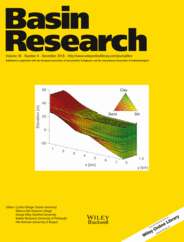
Full text loading...
 , David C. P. Peacock1
, David C. P. Peacock1
Reverse reactivation of normal faults, also termed “inversion”, has been extensively studied, whereas little is known about the strike‐slip reactivation of normal faults. At the same time, recognizing strike‐slip reactivation of normal faults in sedimentary basins is critical, as it may alter and impact basin physiography, accommodation and sediment supply and dispersal. Motivated by this, we present a study of a reactivated normal fault zone in the Liassic limestones and shales of Somerset, UK, to elucidate the effects of strike‐slip reactivation of normal faults, and the inherent deformation of relay zones that separate the original normal fault segments. The fault zone, initially extensional, exhibits a series of relay zones between right‐stepping segments, with the steps between the segments having subsequently become contractional due to sinistral strike‐slip movement. The relay zones have therefore been steepened and are cut by a series of connecting faults with reverse and strike‐slip components. The studied fault zone, and comparison with larger‐scale natural examples, leads us to conclude that the relays turned contractional steps are associated with (a) complex fault and fracture networks that accommodate shortening, (b) anomalously high numbers of fractures and faults, (c) layer‐parallel slip and (d) folding and uplift. Comparison with published statistics from global relay zones shows that whereas the reactivated relay zones feature aspect ratios similar to those of unreactivated relay zones, bed dips within reactivated relay zones are significantly steeper than unreactivated relay zones. Given the potential of reactivated relay zones to form areas of local uplift, they may affect basin structure and may also form potential traps for hydrocarbon or other fluids. The elevated faulting and fracturing, on the other hand, means reactivated relays are also likely loci for enhanced up‐fault flow.

Article metrics loading...

Full text loading...
References


Data & Media loading...
Supplements

